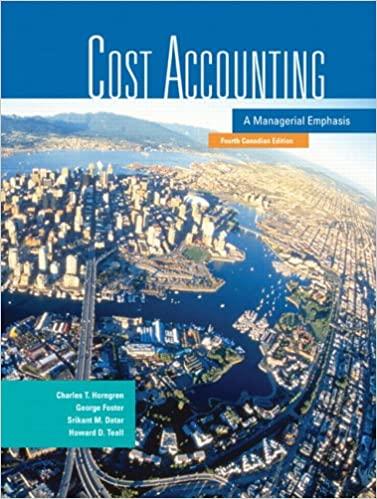ABC, implementation, ethics. (CMA, adapted) Applewood Electronics, a division of Elgin Corporation, manufactures two large-screen television models:
Question:
ABC, implementation, ethics. (CMA, adapted) Applewood Electronics, a division of Elgin Corporation, manufactures two large-screen television models: the Monarch, which has been produced since 2000 and sells for $1,080, and the Regal, a new model introduced in early 2003, which sells for $1,368. Based on the following income statement for the year ended November 30, 2007, senior management at Elgin have decided to concentrate Applewood’s marketing resources on the Regal model and begin to phase out the Monarch model.
Applewood Electronics Income Statement for the Fiscal Year Ended November 30, 2007 Monarch Regal Total Sales $23,760,000 $5,472,000 $29,232,000 Cost of goods sold 15,048,000 3,830,400 18,878,400 Gross margin 8,712,000 1,641,600 10,353,600 Selling and administrative expense 6,996,000 1,173,600 8,169,600 Operating income $ 1,716,000 $ 468,000 $ 2,184,000 Units produced and sold 22,000 4,000 Net income per unit sold $78.00 $117.00 Unit costs for the Monarch and Regal are as follows:
Monarch Regal Direct manufacturing materials $249.60 $700.80 Direct labour Monarch (1.5 hours X $14.40) 21.60 Regal (3.5 hours X $14.40) 50.40 Machine costs*
Monarch (8 hours X $21.60) 172.80 Regal (4 hours X $21.60) 86.40 Manufacturing overhead other than machine costs1 240.00 120.00 Total cost $684.00 $957.60 *Machine costs include lease costs of the machine, repairs, and maintenance.
^Manufacturing overhead was allocated to machine hours at the rate of $30 per hour.
Applewood’s controller, Susan Benzo, is advocating the use of activity-based costing and activity-based management and has gathered the following information about the com¬
pany’s manufacturing overhead costs for the year ended November 30, 2007.
Activity Centre (Cost-Allocation Base)
Total Activity Costs Units ofthe Cost-Allocation Base Monarch Regal Total Soldering (number ofsolder points) $1,130,400 1,185,000 385,000 1,570,000 Shipments (number ofshipments) 1,032,000 16,200 3,800 20,000 Quality control (number ofinspections) 1,488,000 56,200 21,300 77,500 Purchase orders (number of orders) 1,140,480 80,100 109,980 190,080 Machine power (machine hours) 69,120 176,000 16,000 192,000 Machine setups (number ofsetups) 900,000 16,000 14,000 30,000 Total manufacturing overhead $5,760,000 After completing her analysis, Benzo showed the results to Filipe Figueira, the Applewood Division President. Figueira did not like what he saw. “If you show headquarters this analysis, they are going to ask us to phase out the Regal line, which we have just introduced. This whole costing thing has been a major problem for us. First Monarch was not profitable and now Regal.
“Looking at the ABC analysis, I see two problems. We do many more activities than the ones you have listed. If you had included all activities, maybe your conclusions would have been different. Second, you used number ofsetups and number ofinspections as allocation bases. The numbers would have been different had you used setup-hours and inspection-hours instead.
I know that measurement problems precluded you from using these other cost-allocation bases, but at least you ought to make some adjustments to our current numbers to compensate for these issues. I know you can do better. We can’t afford to phase out either product.”
Benzo knew her numbers were fairly accurate. On a limited sample, she had calculated the profitability of Regal and Monarch using different allocation bases. The set of activities and activity rates she had chosen resulted in numbers that approximated closely those based on more detailed analyses. She was confident that headquarters, knowing that Regal was introduced only recently, would not ask Applewood to phase it out. She was also aware that a sizable portion of Figueira’s bonus was based on division sales. Phasing out either product would adversely affect the bonus. Still, she felt some pressure from Figueira to do something.
Requieed 1. Using activity-based costing, calculate tire profitability ofthe Regal and Monarch models.
2. Explain briefly why these numbers differ from the profitability of the Regal and Monarch models calculated using Applewood’s existing costing system.
3. Comment on Figueira’s concerns about the accuracy and limitations ofABC.
4. How might Applewood find the ABC information helpful in managing its business?
5. What should Susan Benzo do?
194 COLLABORATIVE LEARNING PROBLEM
Step by Step Answer:

Cost Accounting A Managerial Emphasis
ISBN: 9780131971905
4th Canadian Edition
Authors: Charles T. Horngren, George Foster, Srikant M. Datar, Howard D. Teall





